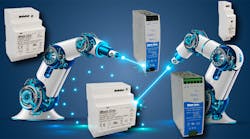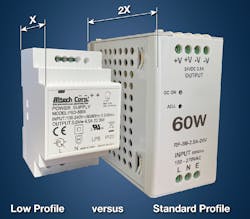Adaptable Low Profile, Compact DIN Power Supplies
A DIN rail system is one of the most efficient methods used to easily mount a variety of industrial control components inside an equipment rack. More often industrial controls are placed as close to the machine they are controlling as possible, further reducing the need for extra stretches of cables and wires. Although this is great for saving money on installation, it can cause real estate problems as everything become increasingly compact. Designed to be versatile and rugged—even for harsh environments—DIN rail systems are used in a wide variety of industries including utilities, building automation, machine tools, and medical equipment.
Besides standard circuit breakers, relays, and terminal blocks, DIN rail systems often incorporate important high-end components such as programmable logic controllers, motor and motion system controllers, and any number of additional special purpose devices meant to connect and interface with the growing IIoT networks in factories, buildings, and utilities around the world. For machine control, DIN rails often require power supplies that are able to integrate with an array of other devices and equipment.
Power Supplies
Standard DIN rail power supplies are typically over 5-inches high, 2- to 4-inches wide, and around 5-inches, or more, deep. These components can take up a lot of space on the rail. As DIN rail systems become tightly packed with devices offering special control features for greater industrial control capabilities, a large number of companies have been forced to solicit custom solutions for their power requirements.
A new series of ultra slim metal case DIN rail power supplies have been designed and manufactured by Altech that takes up less than half the space that a current power supply would normally occupy on a DIN rail. In comparison to standard 120 Watt DIN rail supplies that take up about 2 ½-inches of DIN rail space, Altech’s PSC-120 series would need only 1¼-inches of space on the DIN rail. These ultra-compact power supplies make it easy to include additional functionality in the same space as well as for use in shallow cabinets—without increasing costs. These ultra-compact high efficiency units also support 1+1 or N+1 redundancy and built in current sharing functions. These supplies also allow space for additional features to be added to a system on the same DIN rail.
Universal Input and Output
The Altech DIN rail power supplies are offered with a universal input feature that sets them apart from other products on the market. Regardless of power supply output, each product in the PSD and PSC series has an input requirement of 85-264 VAC/127-360 VDC. Output specifications vary for each unit in the series; for example, the PSC series power supplies provide outputs from 12 VDC to 48 VDC and up to 480 Watts. The PSD series power supplies cover wattages from 15 Watts up to 100 Watts and standard voltages include 5, 12, 15, 24 and 48VDC.
These new PSD and PSC DIN rail power supplies are particularly geared toward applications where the use of narrow cabinets is a necessary requirement due to real estate restrictions. This is particularly the case with the increased number of robots and cobots that are being produced today. The more portable an industrial machine becomes, the more important it is to have the controls—and power supply—available in a compact unit.
Up-to-Date Certification
Certification is a key requirement in industrial systems design and manufacturing for worldwide distribution. This includes new safety standards based on IEC 62368-1, which are superseding existing standards. While trying to keep things simple for product vendors, regulators in the U.S. and EU had agreed on the date the new standards would supplant the outgoing 60950-1 and 60065 standards. Vendors were provided this unified target to focus their regulation compliance efforts in two of the most important worldwide markets. On December 20, 2020, the old standards were withdrawn, and any product covered by the scope of EN 62368-1 (the IEC standard as written into law by EU legislators) had to be tested in accordance with the new standard.
Following the EU's announcement, the UL organization in the U.S. confirmed it would move its own Effective Date for UL 62368-1 (the US version of IEC 62368-1) to supersede UL 60950-1 and UL 60065 as well. Therefore, everything changed at the end of 2020. And as the rule-makers have harmonized across the waters, OEMs must now have their new testing procedures and documentation in place.
Changing to an HBSE-Based Standard
IEC’s technical committee had adjusted their standards-making philosophy to aim toward a less prescriptive and more future-proof document that helped create safer products for end users. With equipment increasingly operating in and around humans, we have officially entered the era of Hazard-Based Safety Engineering (HBSE) (see Figure 1). HBSE shifts the emphasis away from demonstrating that prescribed specifications have been met and requires product manufacturers to demonstrate that known hazards have been considered and the product has been designed to be safe to use in the expected context—such as cobots operating alongside a human in a production setting.
HBSE principles work to protect equipment users by identifying any potentially hazardous energy sources and the mechanisms by which the energy could transfer to a user, while proposing suitable means of preventing those transfers from happening. The scope includes normal operation and fault conditions. Safeguards are put in place to protect against pain or injury caused directly by electrical energy (electric shock) or thermal burn injury, and/or to prevent electrically caused fires that could result in pain, injury, death, or property damage. Importantly, HBSE also measures the effectiveness of the safeguards.
It is important for product designers to recognize that the new standards apply not only to the end product but also to major components and subsystems used inside the product, such as the power supplies. For this reason, Altech has made sure that all their power supplies for their PSD and PSC series meet the latest standards. New 62368-1 hazard-based safety standards have been fully adopted in the U.S., Canada, EU, and other countries/ regions. The older standards have been withdrawn. OEMs must test their new (and existing) products in accordance with the new standard.
Conclusion
DIN rail systems are used to save time and costs, allowing components to simply snap or slide into place rather than panel mounting each component separately. This is particularly advantageous for equipment that is operated near and around humans, such as the growing cobot industry. Power supplies for these systems are a key component and must meet the latest certifications as well as operate efficiently. Altech, once again, has stayed abreast of all the latest requirements for the wide variety of industries they serve and are able to supply components that offer high performance at reasonable costs.




